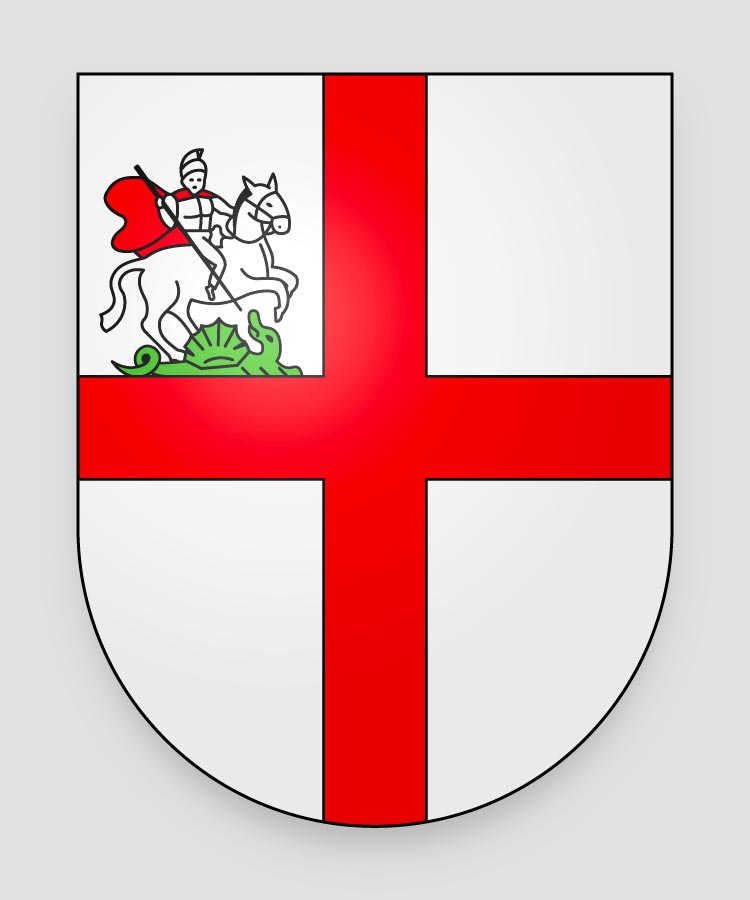Coat of arms

Brissago belongs to the ranks of those municipalities that can boast a history of their own. The events of the village overlooking the right bank of the Verbano constitute in many ways a case in itself, a unicum of local historiography.
Two of the most significant chapters of this story are set on the banner adopted by the municipality in 1903 on the occasion of the first centenary of the autonomy of the Canton of Ticino.
The first is symbolized by a large red cross: It is the name of the Municipality of Milan, to whose domain Brissago was subjected in the Middle Ages. In fact, from the middle of the 14th century, the Visconti included Locarnese in their sphere of influence.
At the beginning of the 16th century, the Swiss, called in Italy by the Franco-Spanish Wars, conquered Locarno, also occupying the village on Lake Maggiore.
While the Locarno bailiwick was finally recognized to the Swiss in 1516, years of uncertainty still followed for the Republic of Brissago. Doubts were dispelled on St. George's Day (April 24) in 1521, when Brissago decided to put himself under the protection of the twelve Swiss cantons. This act of voluntary dedication marked the historical destiny of the community: with good reason, therefore, the municipal coat of arms shows the figure of St. George, which recalls the day on which Brissago left the Milanese orbit to enter definitively into the Swiss one.
History
Already around the year 1000 B.C., in Brissago, we find the first human intervention in the work of terracing the territory. Among the populations that in ancient times inhabited this region we can count the Ligurians and Celts, who had human settlements of some importance. With the Romans, there was a change of civilization and the introduction of cultures (vine, chestnut, walnut, ...) that later profoundly determined the economy of the country.
In the early Middle Ages, on the model of what happened in nearby Padania, forms of government were created on the model of those of the Italian municipalities.
With the feudal age and the rustic municipality, Brissago gave itself its first legal structures (rustic statutes) and religious (separation from the Pieve di Cannobio). The ownership and exploitation of the land (neighborhood) were collective, respectively the designation of political leaders (the podestà, the consuls, the belief) took place by appointment from below. Although there were strong links with the Pieve Ambrosiana di Cannobio, legal and institutional autonomy was guaranteed by the statutes.
The birth of a first local bourgeoisie gave a strong impetus to trade, manufacturing, art and culture. This rapid development of the economic activities of the village did not lack new outlets in the direction of the markets of Milan.
In the sixteenth century, with the collapse of the Sforza and as a result of the wars of Italy, two rival fractions were created in Brissago: the Milanese party and the Swiss party.
With the power vacuum left by the Duchy of Milan in full decline, Brissago opened the possibility of giving himself republican orders (1515-1521). Unfortunately, the hard infighting, artfully fomented by those who wanted to subjugate the Brissaghese Community, led to serious destruction and numerous mourning.
To put an end to this difficult situation, on St George’s Day in 1521, the Brissaghesi swore allegiance to the Swiss, who in turn recognised the legal value of the village’s statutes.
In the seventeenth century Brissago, reduced to a minimum, turned out to be separate land at the Bailiwick of Locarno. Evidently, for political and economic reasons, the opposition with the Municipality of Locarno began to be felt. Even the administration of the Swiss was often not the happiest, creating quarrels and clashes with the regional pole. In this context, some families of notaries were formed whose administrative commitment kept alive the libertarian traditions of the Brissaghese community.
With the eighteenth century trade took on new development and at the end of the century the ideas of the French Revolution did not fail to inflame the minds of our citizens. However, in public assembly, the Brissaghesi decided democratically to stay with the Swiss.
The 19th century, with industrial capitalism and the first developments in the tourism industry, opened up new horizons. After the birth and upheavals of the Helvetic Republic, in fact, even Ticino (1803) took its modern layout of Canton.
With the birth of the confederal state, little by little, political parties began to assert themselves.
It is also the time of the great emigrations to new continents, caused by the difficult economic situation. From the point of view of foreign policy, the wars of the Italian Risorgimento arouse not only great sympathies (Carbonari and Mazziniani), but also a direct support of the Brissaghesi to the Garibaldini.
At the end of the century was also founded the Tobacco Factory, a driving industry of the village, a tangible sign of the nascent industrial era.
The twentieth century saw the emergence of the hotel industry with the construction of the Grand Hotel (1907), the Brenscino Hotel (1913), etc., which meant that the places were very attractive to tourists.
On this positive impulse, a cultural life developed that in people like Roger Leoncavallo (an honorary citizen in 1904) found one of its leaders.